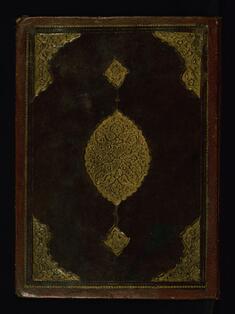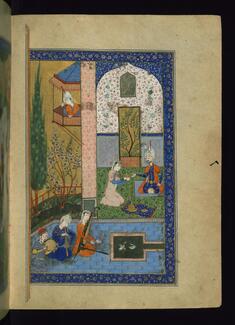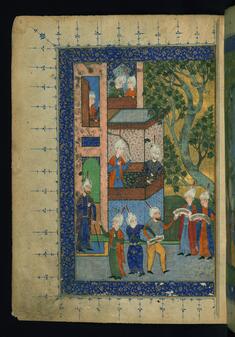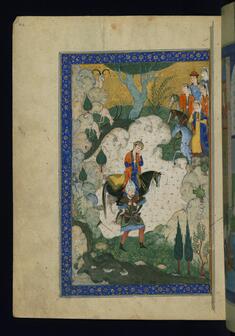Five Poems (Quintet)
(Manuscripts and Rare Books, Islamic World , Islamic Manuscripts)
Walters manuscript W.663 is a Safavid illuminated and illustrated collection of the Hamse (quintet), written in Çagatay (eastern Turkic), composed by the celebrated 'Ali Šir Neva'i (died 906 AH/AD 1501), and inspired by the Persian Khamse of Nizami and Amir Khusraw Dihlavi. This copy dates to the 10th century AH/AD 16th and has 5 double-page illustrations in the early Safavid court style. Each double-page illustration introduces the following individual poems: Kitab-i heyrat ül-ebrar (fols. 1b-2a), Kitab-i Ferhad va Sirin (fols. 45b-46a), Kitab-i Mecnun va Leyla (fols. 108b-109a), Kitab-i Hest bihist (fols. 147b-148a), and Kitab-i Iskendername (fols. 199b-200a). Each poem is also introduced by an illuminated incipit (fols. 2b, 46b, 109b, 148b, and 200b). The brown goatskin binding has a central lobed oval with pendants and cornerpieces brushed with gold. It is possibly attributable to the10th century AH/AD 16th.
Provenance
Provenance (from the French provenir, 'to come from/forth') is the chronology of the ownership, custody, or location of a historical object. Learn more about provenance at the Walters.
Henry Walters, Baltimore [date and mode of acquisition unknown]; Walters Art Museum, 1931, by bequest.
Exhibitions
| 1998 | Mything Persons: Historic Figures in Legends of East and West. The Walters Art Gallery, Baltimore. |
| 1980 | Islamic Insights. Katonah Gallery, Katonah. |
Geographies
Turkey (Place of Origin)
Measurements
Folio H: 9 1/4 x W: 2 9/16 in. (23.5 x 6.5 cm)
Credit Line
Acquired by Henry Walters
Location in Museum
Not on view
Accession Number
In libraries, galleries, museums, and archives, an accession number is a unique identifier assigned to each object in the collection.
In libraries, galleries, museums, and archives, an accession number is a unique identifier assigned to each object in the collection.
W.663







